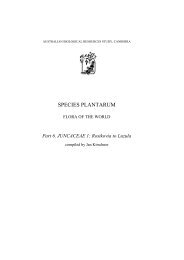Introduction - Species Plantarum Programme
Introduction - Species Plantarum Programme
Introduction - Species Plantarum Programme
Create successful ePaper yourself
Turn your PDF publications into a flip-book with our unique Google optimized e-Paper software.
28<br />
SPECIES PLANTARUM — FLORA OF THE WORLD (1999)<br />
in the IUCN Red List Categories standard (1994) – Extinct, Extinct in the wild, Critically<br />
endangered, Endangered, Vulnerable, Lower risk, as defined in that work.<br />
Infraspecific taxa<br />
The treatment of infraspecific taxa may be seen in Anthocercis viscosa. Following the<br />
species description the overall distribution of the species is given and a statement of the<br />
number of infraspecific taxa. These are then keyed out. When there are only two taxa the<br />
couplet is not numbered. The taxa are referred to in the key by the sequential number of the<br />
species followed by a, b, etc., and the infraspecific rank and epithet. For each taxon there is a<br />
numbered heading with the name in full. Citation of references and synonyms follows the<br />
same format as for species treatments. There is a short description or diagnosis which should<br />
include at least the characters used in the preceding key. Distribution and specimen citation<br />
follow the usual format.<br />
1. Anthocercis viscosa R.Br., Prodr. 448 (1810)<br />
T: Western Australia: King George Sound, R.Brown s.n.; iso: BM.<br />
Erect, sometimes spreading or straggling viscid shrub to 3 m, pubescent with glandular<br />
hairs. Leaves obovate to ovate, almost sessile, 20–60 mm long, usually 10–30 mm wide,<br />
minutely serrulate-crenulate. Inflorescence a cyme, 1–3-flowered, pedunculate; pedicels<br />
5–15 mm long. Calyx 3–15 mm long. Corolla 20–48 mm long, white to creamy white, the<br />
striations green or purplish; lobes ovate-triangular to linear, 12–25 mm long, sometimes with<br />
pale purple streaks. Stamens 4.5–12.5 mm long. Capsule ovoid to ellipsoidal, acute or<br />
apiculate, 8–19 mm long. Seeds 1.8–3 mm long. Sticky Tailflower. [77 words]<br />
Endemic in Western Australia along the southern coastline westwards from Cape Arid.<br />
Always associated with granite outcrops. Suspected of poisoning stock. There are two<br />
subspecies.<br />
Corolla lobes 1.5–2.5 times longer than wide and less than 1.5 times as long<br />
as corolla tube 1a. subsp. viscosa<br />
Corolla lobes 3–5 times longer than wide and usually twice as<br />
long as corolla tube 1b. subsp. caudata<br />
1a. Anthocercis viscosa R.Br. subsp. viscosa<br />
A. viscosa var. baueriana Benth. in A.P.de Candolle, Prodr. 10: 191 (1846). T: based on S.L.Endlicher,<br />
Iconogr. Gen. Pl. t. 68 (1839).<br />
Calyx usually 8–13 mm long. Corolla usually 30–40 mm long; tube about half length of<br />
corolla; lobes 7–15 mm wide. Stamens 8–13 mm long. [20 words]<br />
Western Australia: from Bremer Bay to Albany, and near Denmark. 50. WAU. Map 1.<br />
50. WESTERN AUSTRALIA: Albany, A.M.Ashby 1993 (AD); Two Peoples Bay, N.T.Burbidge 8140 (AD,<br />
CANB); Frenchman Bay, R.Garraty 43 (PERTH); Bremer Bay area, L.Haegi 1858 (BRI, CORD, F, MEL,<br />
NSW, PERTH).<br />
1b. Anthocercis viscosa subsp. caudata Haegi, Telopea 2: 175 (1981)<br />
T: Western Australia: Condingup Peak, c. 62 km ENE of Esperance, 6 Oct. 1976, L.Haegi 1225; holo:<br />
PERTH; iso: AD, CANB, K, L, MO, NSW.<br />
Calyx 3–6.5 mm long. Corolla 20–30 mm long; tube c. one quarter to one third length of<br />
corolla; lobes 3.5–6.5 mm wide. Stamens 4–8 mm long. Fig. 1. [24 words]<br />
Amended from Fl. Australia 29: 7 (1982)












